Planning a trip to the southernmost tip of India, Kanyakumari? Here’s your detailed Kanyakumari travel guide, which covers the sights of interest, how to reach Kanyakumari, and the best time to visit this travel destination.
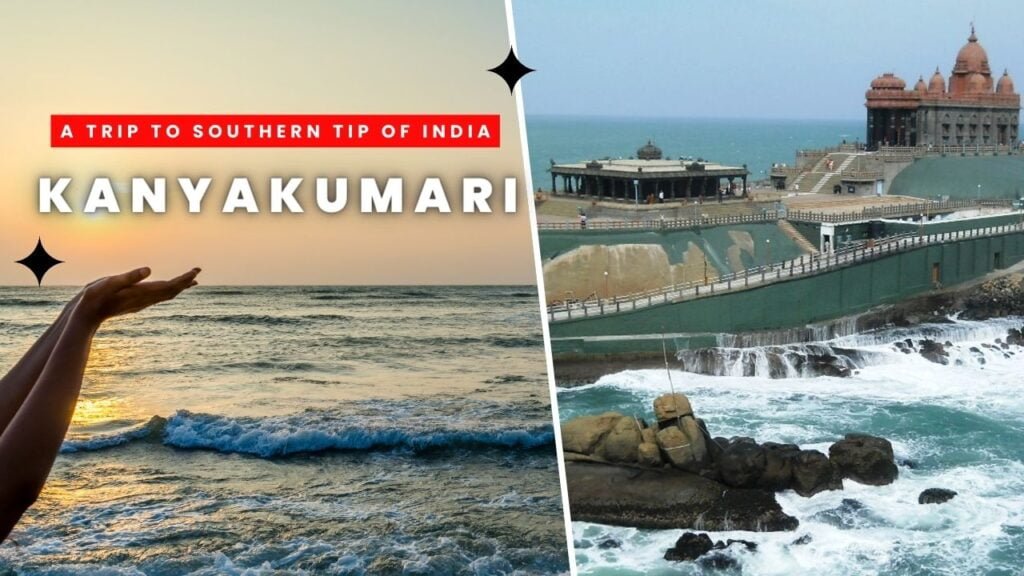
A ‘tip’ may sound trifling and of little consequence, but make no such gaffes when speaking of the southernmost tip of India named Kanyakumari.
Commonly seen on the map of India as a petite patch of land surrounded by two seas (Arabian & Bay of Bengal) and one ocean (Indian), the coastal township is in effect buoyed all around by the Laccadive Sea. No doubt Kanyakumari is as phenomenal as it seems in panoramic shots of expansive waterscapes, but it is all the more than meets the eye.
Right from mythos that is neither proved nor denied about the town to have once been a part of the submerged continent called Kumari Kandam, to have been a part of the thriving kingdom of Travancore (Kerala), to being labelled as Cape Comorin during British rule, to finally becoming a tourist magnet of Tamil Nadu – this ‘tip’ has borne the weight of a long history ever since long lost times that has carried along with it some un-erasable legendary notes, cultural practices and religious beliefs.
In a country of diversity and diversities within diversity, to know that even a town at the ‘tip’ could have a bagful of offerings is something to be immensely proud of, as would be perceptible after reading about the many sights of interest in Kanyakumari:
Bhagavathy Amman Temple
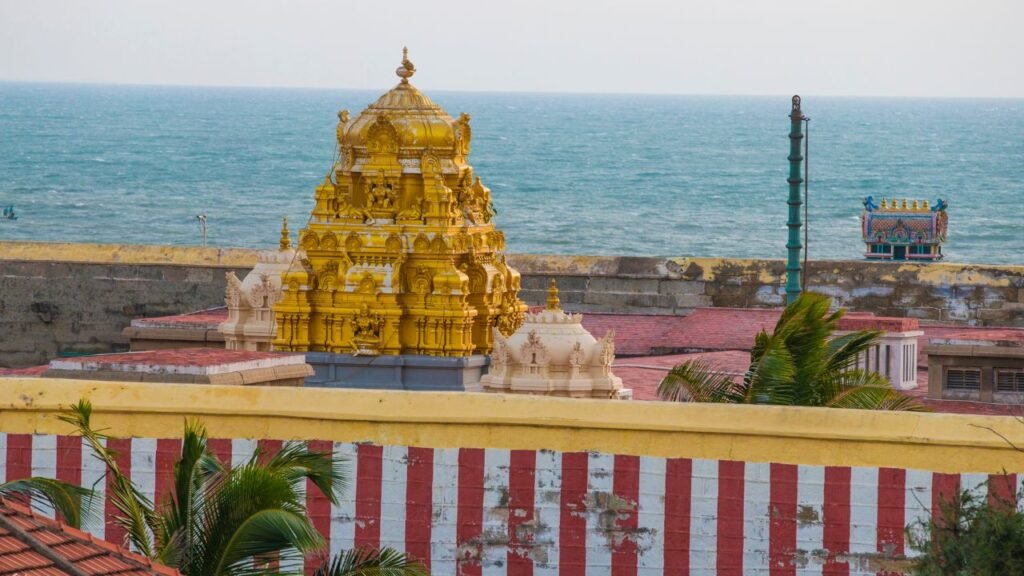
Dating back to Puranic era, Sage Parasuraman is said to have installed the deity of Devi Bhagavathy Amman (Kumari Amman) on the sacred shores of Kanyakumari, right behind which is a holy confluence of the three seas (Triveni Sangamam); and consequently has been special as a pilgrim centre for over three millenniums, as for also being considered as a Shakti Peetha Temple.
The deific form in the Temple seen with a rosary garland in Her right hand is worshipped as a Goddess of penance and virginity.
Thiruvalluvar Statue
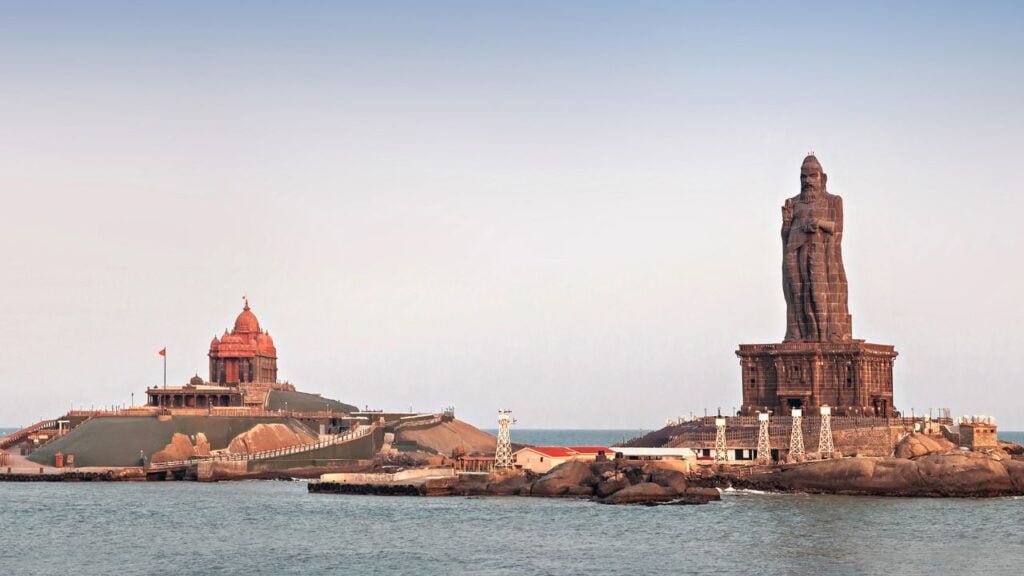
“Ollum Vakaiyaan Aravinai Ovaadhe “Incessantly practice virtue,
Sellumvaai Ellaan Cheyal” Always and everywhere.”
Saint Thiruvalluvar composed 1330 such mind-bending seven-worded couplets (Thirukkural), precisely weaved around the morality of human beings. Widely acclaimed to be among the earliest treatises of not just Tamil language but Indian literature on the whole; through and through all his chapters, the scholar rigorously underscores virtues surrounding duty, kindness, wealth, charity, gratitude, love and so forth, for all classes of people belong to all strata of society; thus becoming a sort of cultural constitution upheld by Tamilians for centuries till date. Further confirmed to be among the highest translated works in more than 40 other languages (Indian and foreign), Thriuvalluvar’s work has had a deep-rooted influence on leaders like Mahatma Gandhi who have sung praises about the ‘treasure of wisdom’.
An honorary statue (sculpted by V. Ganapati Sthapati) bounded by the ocean, 400 m away from the shore of Kanyakumari, standing sky-high at 133 feet (to denote 133 chapters of Thirukkural) and weighing a massive 7000 tonnes – was unveiled by Dr. M.Karunanidhi, then Chief Minister of Tamil Nadu on January 1st, 2000. The right hand of the solemn statue has three fingers straight up, heralding Aram (virtue), Porul (Wealth) and Inbam (Love) – the 3 keynotes of Kural text.
Vivekananda Rock Memorial
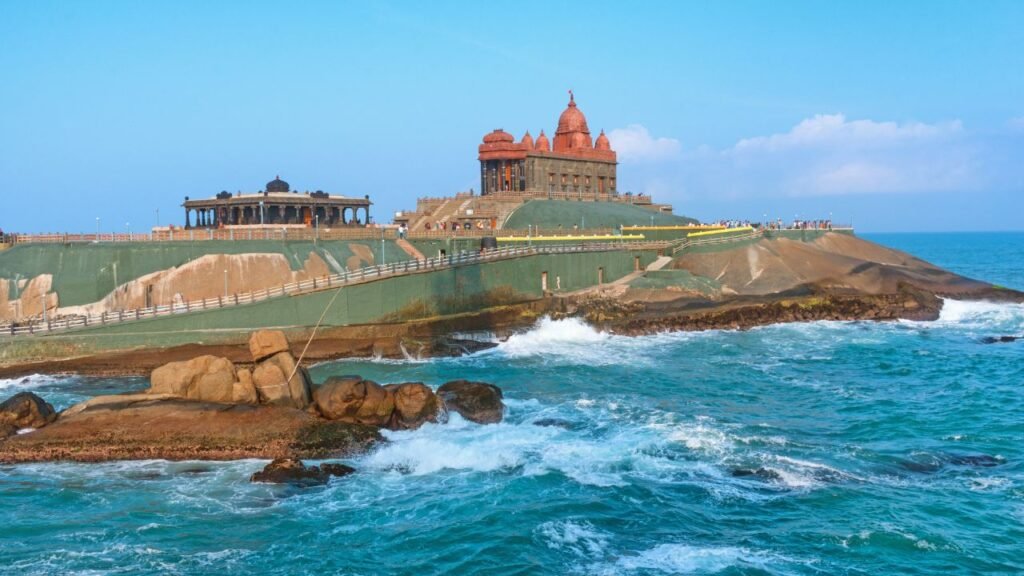
A philosopher, social reformer, religious teacher and spiritual leader, Swami Vivekananda, became the focus of public attention after the 1893 ‘Parliament of Religions’ in Chicago (USA) where he spoke on Hinduism. Legends say that he visited Kanyakumari just before, in the year 1892 to seek the blessings of Goddess Kumari Amman, then swam across from the shore to reach a rock afloat mid-sea, and sat there to meditate, three days after which he truly attained enlightenment. (This is also the same rock where the Goddess is said to have left Her footprints after she performed her penance {SriPadaparai}.)
Spearheading a campaign to fulfil the objective of ‘Vivekananda Rock Memorial’, his disciple Eknath Ranade managed the task of collecting donations from all over the country for the purpose. Located on a voluminous and uneven rock island adjacent to Thiruvalluvar Statue, and inaugurated in 1970, the ‘red & grey’ stone-memorial complex constitutes two elegant constructions – Vivekananda Mandapam (meditation halls, rooms, corridors and statue of Swami Vivekananda) and Shripada Mandapam (pillared square platform).
[Ferries frequently ply about (8 a.m. to 4 p.m., ticket for Rs. 50) to shuttle visitors to both Vivekananda Rock Memorial and Thiruvalluvar Statue (same ride) from the mainland and back. Other than the arduous task of passing through long snaking queues to catch a place on the boat {sometimes even with a special ticket of Rs. 200), the jaunt across is one to remember as the sea – winds-n-waves lightly toss the ferry side to side, taking 10-15 minutes to reach the islets. Given half an hour to see around both, being engulfed by cool ocean breeze while roaming on the formidable rock surfaces, encircled by overwhelming waters of the Laccadive Sea, is reason enough to cause goosebumps!
A proposed glass bridge between these two monuments could soon be a reality!]
Sunset Point
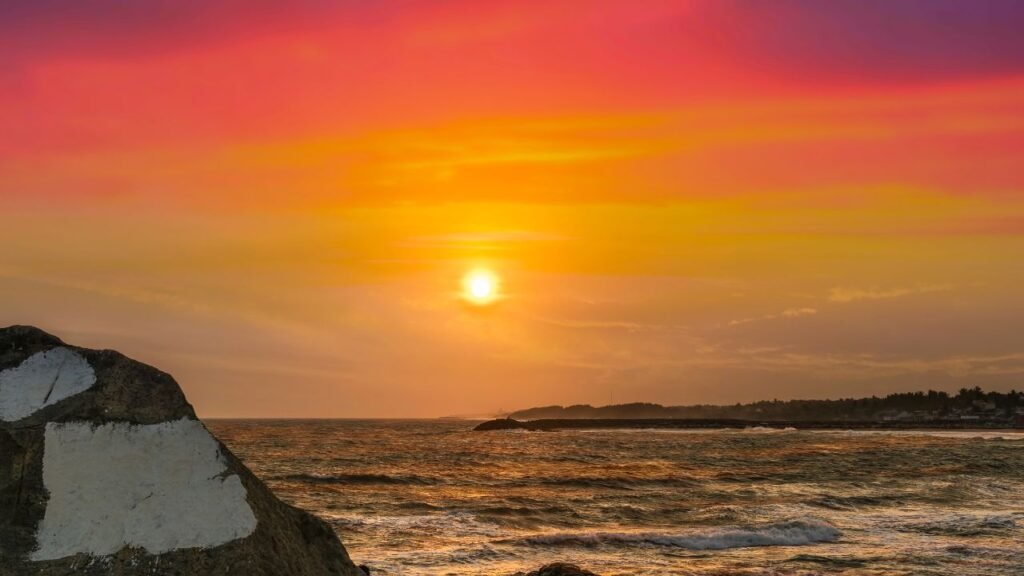
Standing on the southernmost tip of India, where the land, sky and seas meet, to watch sunrise/sunset is one of the most irresistible experiences of a lifetime, for this is one of the rare places on earth where both happen at the same point!
The Hidden Twin beach (two adjacent beaches separated by enormous rocks), which can be easily reached by the Beach Road, is the standout place to witness the divine twilight phenomenon. Other equally entrancing viewpoints would be – a watchtower at Kanyakumari beach and a stone pathway trailing into the ocean for a short distance called as the Pier.
Kanyakumari Beach
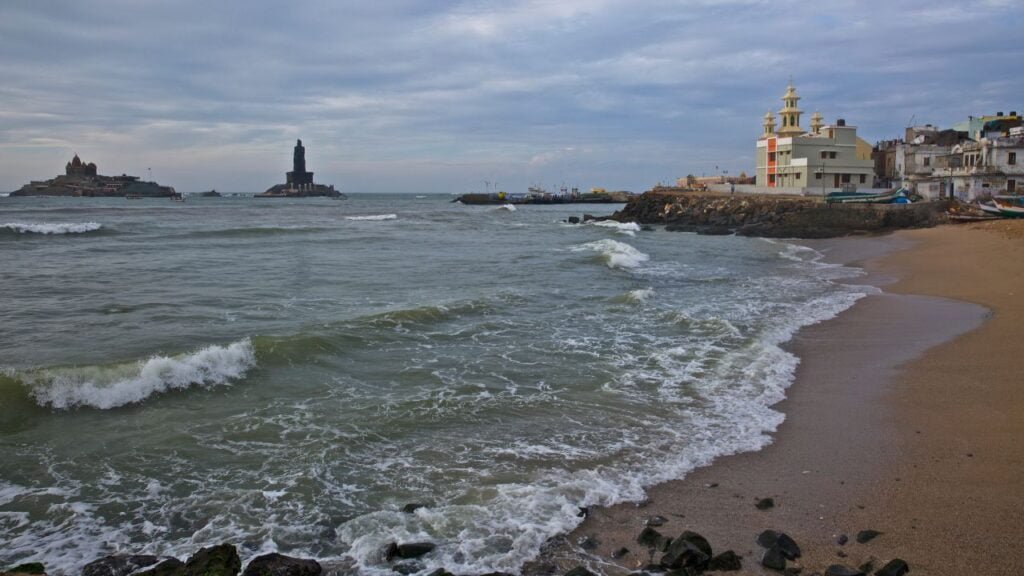
The most exhilarating part of being at the edge of the tapering peninsular of our country is watching wild waves rising from the conflux of the three water bodies – Indian Ocean, Arabian Sea & Bay of Bengal, and hitting the rocks ashore on Kanyakumari Beach which is literally the land’s end. This is the ideal location from where people stop in their tracks wide-eyed, time and time again, to picture the two stupefying structures on water, Vivekananda Rock Memorial and Thiruvalluvar Statue.
More beautiful than photographic promises – though the mind could be playing out delusions as to whether to marvel at the endlessness of the sky, or the borderlessness of the waters – both in a color so cerulean with pinches of fluffy whites and rays of gold – being at the ‘tip’ is an experience that will surely get deeply etched into everyone’s heart!
ALSO READ: 10 BEST PLACES TO VISIT IN RISHIKESH – THE COCKTAIL CULT OF SPIRITUALISM AND ADVENTURISM
Suchindram Thanumalayan Temple
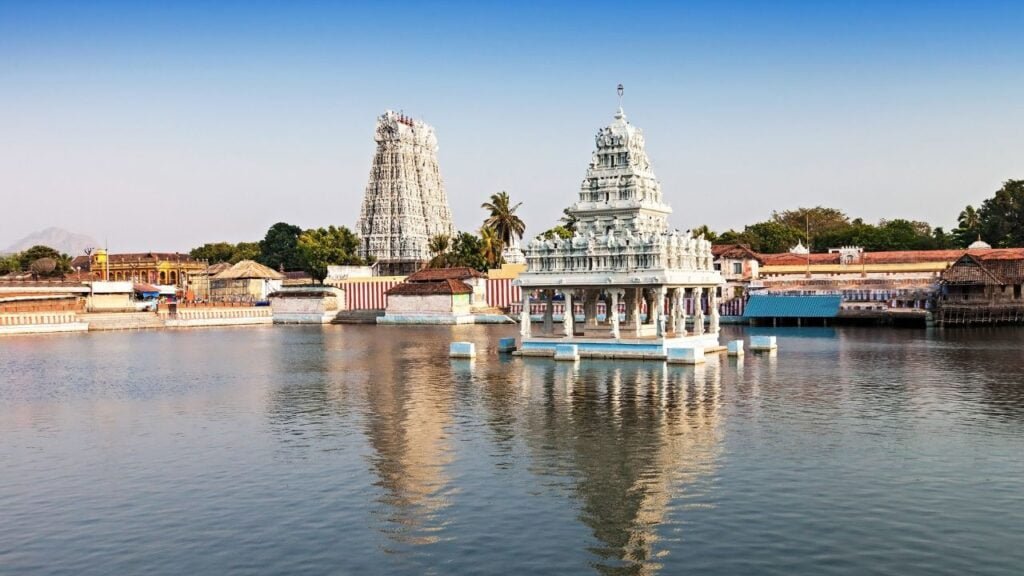
An old world orthodox temple at Suchindram, 14 km from Kanyakumari that enshrines the Trinity of Gods (Shiva, Vishnu & Brahma) en-route to Nagercoil (6km). An amalgam of Kerala and Tamil Nadu architectural styles, the temple towers with a 144-feet high gopuram and possesses a wealth of sculptures. Other specifics are a wooden mandapam for Navaratri celebrations, 1000 pillars in the dancing hall, a 22-feet high Hanuman statue and a 13-feet tall Nandi statue. Pilgrims particularly look out for ‘four musical pillars’ (produce various musical notes when struck) about 5.5 meters in height each that have been cut out of a single granite block.
Padmanabhapuram Palace
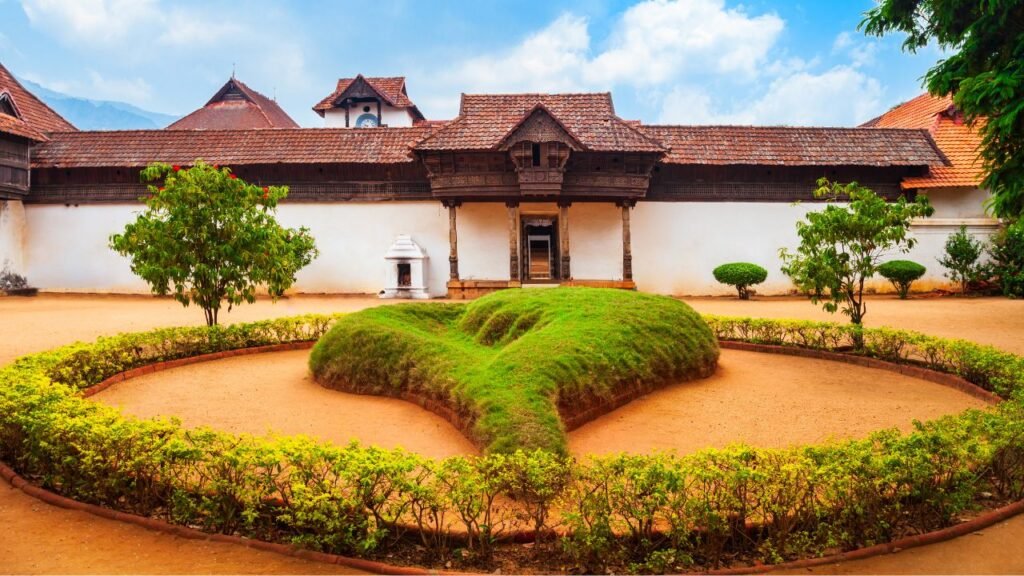
Quite unlike any other palace in India or even anywhere else in the world, Padmanabhapuram/Kalkulam Palace is the best thing since sliced bread in Keralite architecture and craftsmanship in about 500 years. Yes! Although present 33 km away in Thuckalay town (Kanyakumari district) of Tamil Nadu, it is controlled by the Government of Kerala as the Palace was once the amour propre of the Travancore monarchs before they shifted their capital to Thiruvananthapuram.
Although the origins can be traced back to 1601 CE, the wooden palace was ordered to be rebuilt in its current form by the King of Travancore Marthanda Varma in 1750, who then pledged the stately home to his family deity, Lord Padmanabha.
Too many overwhelming features in the palace oiled the wheels of the decision to convert it into a museum in 1935:
- A 4-storeyed Central Mansion housing the King’s rooms graced with a gallery of murals, carved wooden beams, latticed wooden windows, roofs with triangular gables and floral engravings. The King’s bedstead is supposedly made of 64 types of herbal woods.
- Uppirika Malika or the top floor served as the worship chamber.
- Thai Kottaram or Queen Mother’s chamber, with jackfruit tree trunks as pillars supporting a wooden ceiling.
- Mantrasala or the council chamber with royal furniture and rounded wooden pillars
- Natakasala, a performance house
- Durbar Hall is noted for its distinctive smooth black flooring, made out of an unheard combination of egg whites, jaggery, burnt coconut, lime, charcoal and river sand.
- Poomukham, reception hall with a 300-years old hanging brass lantern
- Oottupura or the dining hall that had a capacity for 1000-2000 people every day
Vattakottai Fort
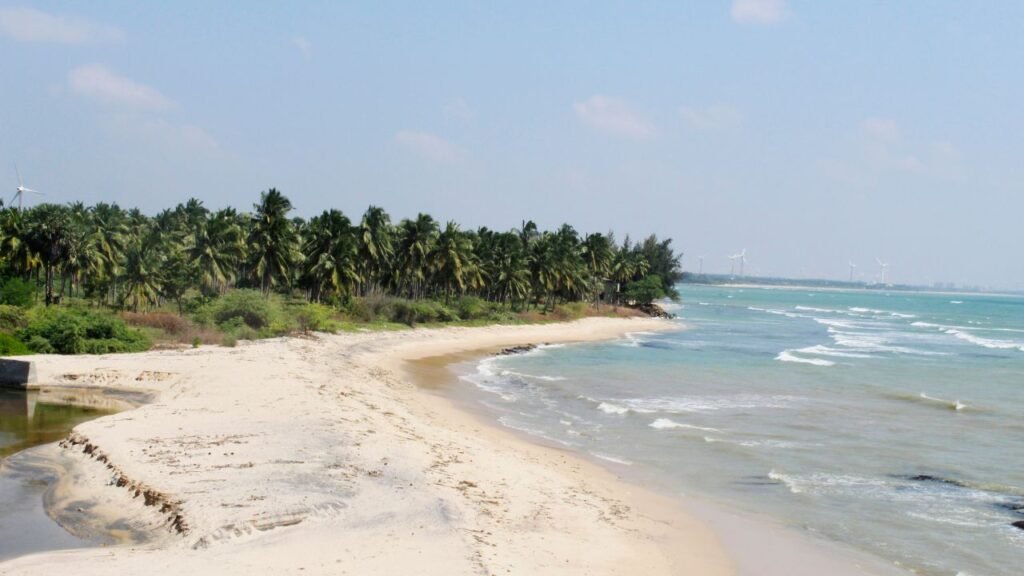
7 km away from Kanyakumari town, Vattakottai is a coastal defence fort by the seaside which was built for the Kingdom of Travancore during the 18th century. (Boat rides to Vattakottai have been recently launched)
The Fort made out of granite stones deserves a special mention as it is believed that during earlier days, the Padmanabhapuram Palace was not only visible from the top, but was also connected to the Fort through a secret tunnel.
ALSO READ: TOP 12 CHANDIGARH PLACES TO VISIT – MOST AMAZING DESTINATIONS YOU MUST VISIT IN ‘THE CITY OF BEAUTY’
Gandhi Mandapam
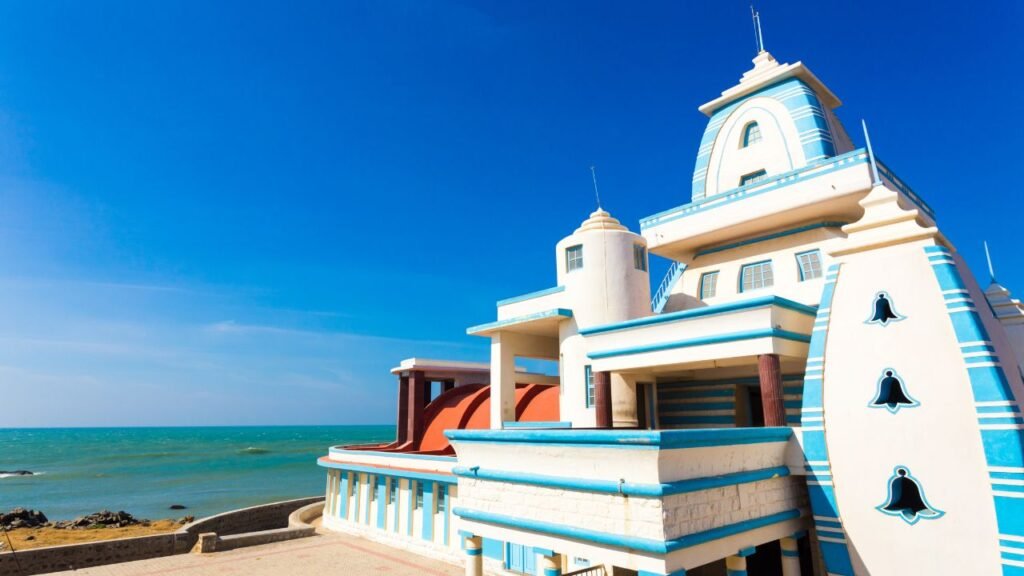
Located on shores within sight from the Thiruvalluvar Statue, is a memorial in honour of Mahatma Gandhi. Not many would know that Gandhiji himself had visited Kanyakumari twice; and that after his passing one of the 12 urns containing his ashes was brought here to be immersed in sea.
Resembling Odisha’s architectural style, the central spire of the edifice has been made to a height of 79 feet {to represent the age of his demise}. Further, it is said that every 2nd of October on his birth anniversary, the sun rays pass through an opening in the ceiling to fall exactly on the spot where his ashes were kept.
Visitors are expected to maintain discipline & decorum while inside be it while viewing his photographs or while browsing through the library.
Adjacent to it is ‘Kamarajar Mani Mandapam’ dedicated to Sri Kamarajar, freedom fighter and former Chief Minister of Tamil Nadu, famously known as ‘Perunthalaivar’.
Our Lady of Ransom Church
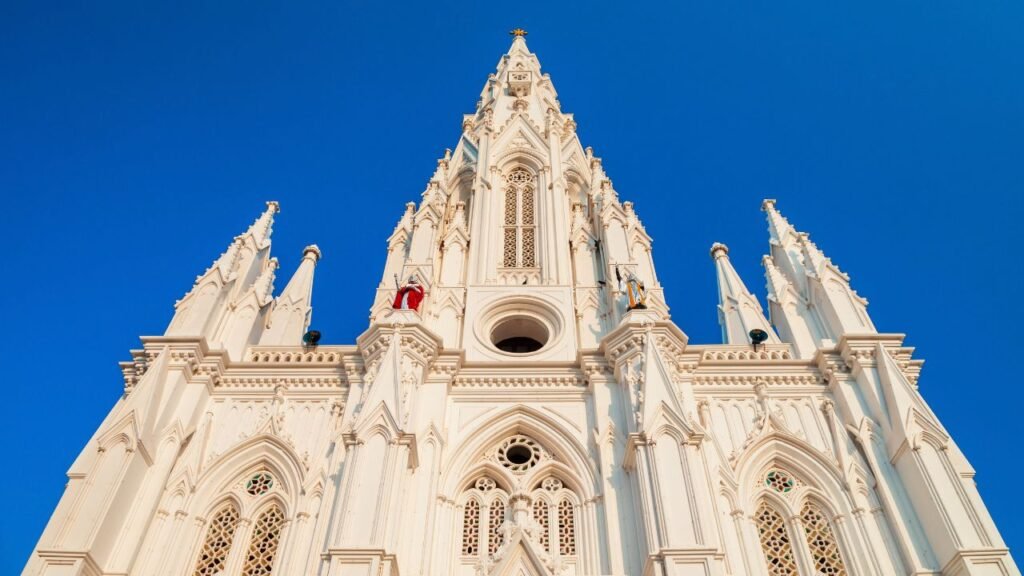
The byword for Gothic architecture in Kanyakumari, the church grew out of the former ‘Our Lady of Delights Grotto’ {16th century} by St. Francis Xavier, a Spanish Catholic missionary and saint. The church is well placed in society for running schools and hospitals.
Particular architectural elements that make a visit worthwhile include a 16th-century statue of Mother Mary brought from Rome and placed on a golden altar, 12 towers to represent 12 disciples of Jesus, 7 doors to depict ‘7 gifts of the Holy Spirit’, church bells imported from Italy in 1900, and statues of St. Thomas the Apostle and St. Francis Xavier on the main tower.
A 10-day annual feast in the month of December that culminates in a ‘golden chariot procession’ sees pilgrims from all over the country.
Francis Xavier’s Cathedral
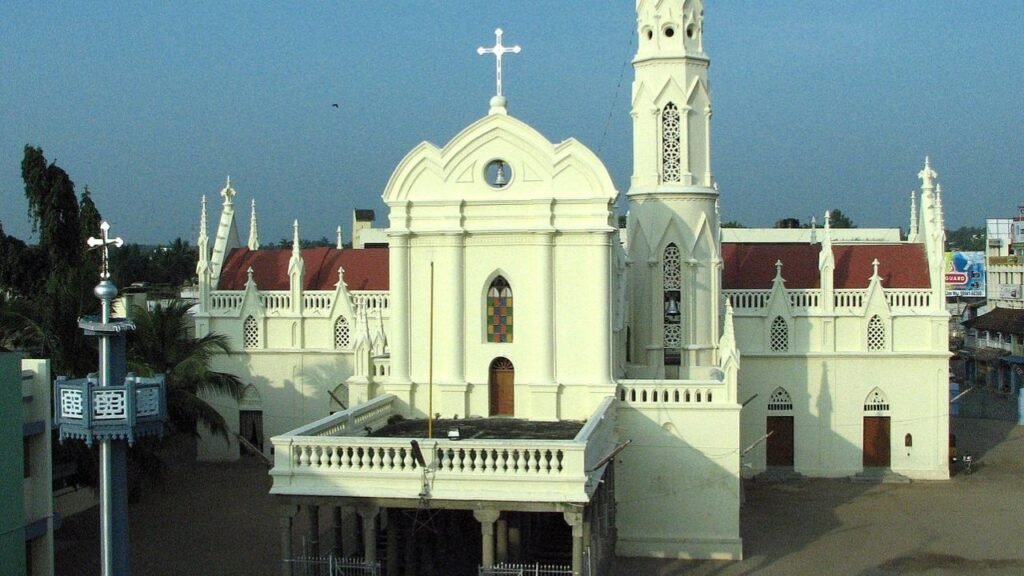
A Roman Catholic shrine in Kottar locality of Nagercoil within Kanyakumari district, was built in appreciation for St. Francis Xavier’s exceptional missionary services as well as for averting attacks from enemies using his miraculous powers.
ALSO READ: ROYAL RENDEZVOUS IN UDAIPUR: LAKES, PALACES AND TEMPLES YOU MUST VISIT
Tsunami Memorial Park
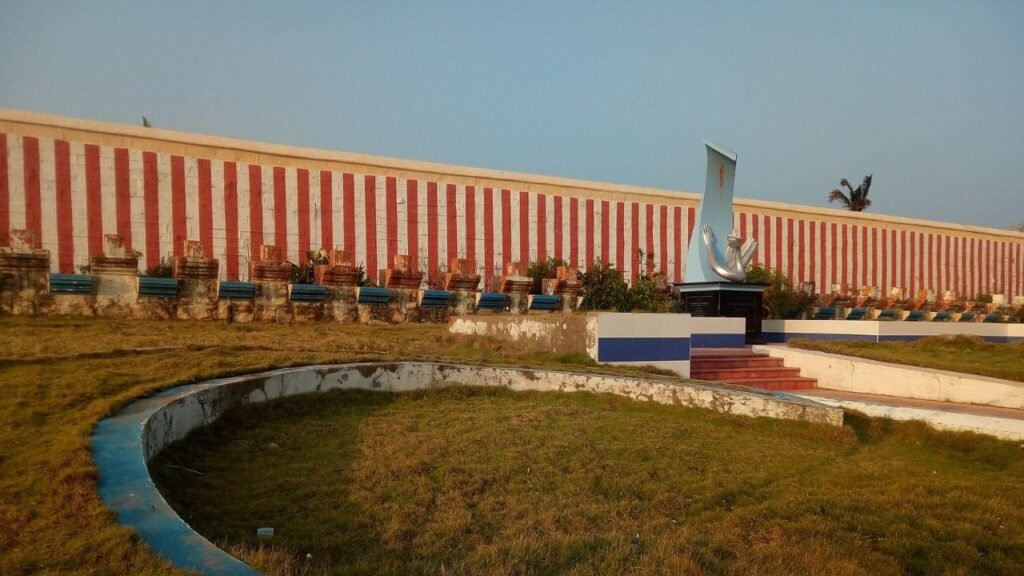
A 16-feet high steel structure {designed by B. Kanagaraj Cangan} showcasing two hands: one obstructing a blue sea wave and the other holding a lamp of hope, was built in memory of lost lives during the tragic ‘tsunami’ of December 2004. Right on the south shore of Kanyakumari beach, the gardened spot is a heartbreaking reminder of the catastrophic event.
Chitharal Jain Monuments
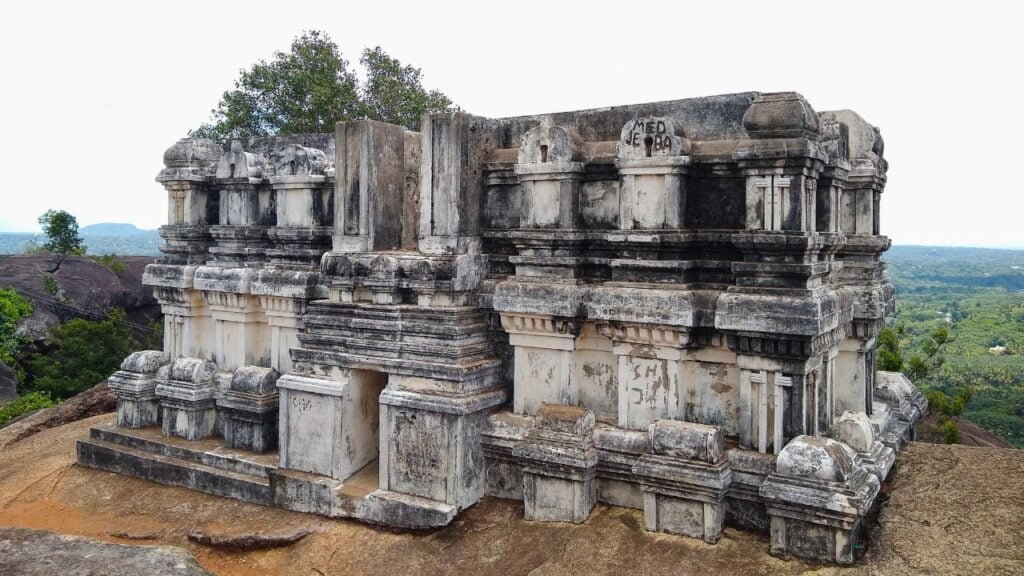
True to the simplistic elements of Jain temple architecture characterized by poise, symmetry, pillars, carvings and inscriptions, Chitharal ‘Malai Kovil’ {hill temple} [50 km northwest of Kanyakumari town] is a Digambara Jain rock-cut temple on a stone-bed, with three sanctums for Parsvanath, Mahavir and Padmavati; belonging to the 9th century CE.
Thirparappu Waterfalls
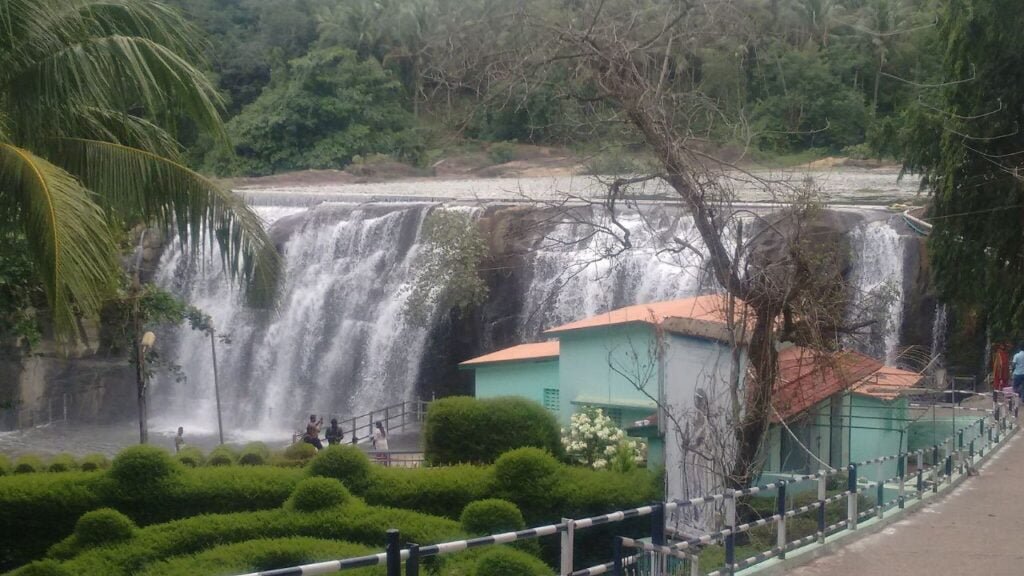
A gush of water sliding down from a height of 50 feet like as if it were a tremendous downpour, making a vast and giant splash onto the pool below, Thirparappu Falls, is 55 km far from Kanyakumari. The onslaught from a wide wall of water, which seems like a cascade of never-ending rain, descends down from Kodayar river, hedged by dense foliage.
ALSO READ: SARNATH – THE PLACE WHERE MANY NATIONS CONVERGE WITH A SINGLE FAITH!
How to Reach Kanyakumari
By Air: The nearest airport is Thiruvananthapuram International Airport (70 km away) from where cabs or buses are available.
By Rail: Kanyakumari Railway Station connects to other stations like Nagercoil, Madurai, Tirunelveli, Rameshwaram and Thiruvananthapuram.
By Road: Buses run to and fro from major cities like Nagercoil, Rameshwaram, Thiruvananthapuram, Tirunelveli, Madurai, Coimbatore, Chennai, and Bangalore.
Best time to visit Kanyakumari
As a coastal town, expect Kanyakumari to always be on the hotter side; so the months between October and February are a better option when the temperature is milder between 24 to 32 degrees Celsius.
Local festivities like Cape Festival (October) and Kumari Thiruvizha (April/May) also draw scores of people.
There is usually no escape from alarming crowds at this place, but that should not deter anyone from treating their soul to an intriguing array of beaches & sunsets, churches & temples, waterfalls & monuments; alongside pampering the taste-buds with mouth-watering Kanyakumari-special Tamilian foods like parotta, nungu sarbath, pazham (banana) bajji, & meen kuzhambu (fish curry).
Other famous beaches within Kanyakumari district worth visiting:
- Sanguthurai beach
- Muttom beach
- Lemur beach
- Thengapattinam beach
- Sothavilai beach
- Paraikal beach
ALSO READ: DISCOVER THE ESSENCE OF KASHMIR IN SRINAGAR – THE BEST PLACES TO VISIT FOR TOURISTS!
